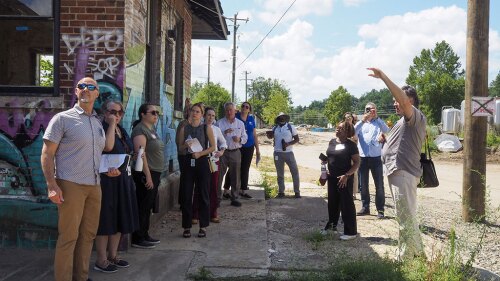When cities decline, they can take decades to recover, if they ever do. McKinsey’s research suggests that many U.S. cities could experience a steady downward trajectory without effective intervention. We find that some cities may take years to bounce back from the impact of the COVID-19 pandemic on real estate and the economy. But such a doom loop is far from inevitable; there are many examples of success that we can learn from. Indeed, while U.S. cities will differ from what they were before COVID-19, this is also an opportunity to shape them into more vibrant and equitable places.
After all, for cities, change is the only constant. In the 20th century, the Great Migration, suburbanization, and the globalization of manufacturing transformed cities. In the first two decades of the 21st century, the knowledge economy fueled growth in technology and service sector jobs, driving the redevelopment of industrial areas and core neighborhoods. When the U.S. economy shifted toward a service-led economy in the late 20th century, some metropolitan areas adapted well, investing in educational and knowledge infrastructure and implementing growth incentives for the private sector. Government regulation, including zoning, encouraged new economic activity. Cities that built such strong ecosystems generally fared better than ones that did not.
Consider Pittsburgh: once known as Steel City, its economy is much more diversified now, with major sectors including robotics, life sciences, and industrial automation. Last century’s mills and factories are now high-tech labs and production facilities. Or Houston, still a major energy hub, but also a leader in aerospace and health care. Or Silicon Valley, which shifted from semiconductor production to become a tech start-up metropolis. These cities evolved successfully because a diverse set of civic leaders created the conditions that let the skills and commitment of its residents flourish.
Our research concludes that a bold urban strategy could be the difference between a decades-long decline and a short-term dip. Adapting to fundamental change requires collaboration, creativity, and a sense of strategy across the public, private, and social sectors. The future is now.
The power of place
Today’s leaders have the opportunity—in fact, the imperative—to learn from history. Cities can continue to attract workers, residents, and visitors if they offer experiences not found elsewhere; they do not have to be just an “office hub.” The key is vibrancy.
Vibrancy is difficult to measure but easy to recognize; it means places with bustling streets and a palpable energy that brings people together—places where people want to be because three elements are pulling in the same direction. First, vibrant areas have a thriving economy, with businesses that support local employment and that attract a range of patrons. Second, vibrant places are magnetic and welcoming, home to different kinds of spaces characterized by active, fluid, and diverse uses. And third, they have a healthy circulatory system that allows people to enjoy the area, and one another—that is, a functioning infrastructure of parks, transit, and city services, including public safety and waste management.
By devising and executing well-thought-out policies that promote vibrancy, U.S. cities can keep changing for the better. To do so, four principles should be kept in mind.
Define a “North Star.” By “North Star,” we mean a clear, forward-looking vision that guides where a city is going and embodies its unique strengths and context.
Without using the term, some cities are finding a North Star. Tulsa’s leaders have set out their vision of Resilient Tulsa—a greener city, with a more diversified economy that addresses its historic racial inequities. Tulsa has also launched a program to attract remote workers. Cleveland’s North Star is to become a “15-minute city,” meaning that residents can live, work, play, and shop, all within a short distance. Such proximity improves quality of life and fosters environmental sustainability. Fresno is deepening its efforts to be a food and agricultural technology hub that will make it a gathering place for the whole San Joaquin Valley. Although these examples are all different, they also all demonstrate how having a North Star can function as an aspirational urban identity.
Having an explicit North Star is useful for three reasons. Orienting toward a well-defined target provides a unified direction that can rally stakeholders. It also establishes a definition of success that can be used to evaluate and prioritize initiatives. A North Star helps to measure overall progress by informing leaders whether they should stay the course or pivot to realign efforts.
Deploy data and technology to understand the environment. Data and simulation modeling can help civic leaders understand where their city is and where it could go. Data lakes are centralized repositories of massive structured and unstructured data from many different sources. Digital twins are simulation and optimization engines that are built upon digital emulations of assets, people, or processes. These advancements represent powerful tools to identify existing problems (such as vacant areas), to weigh possible interventions (such as building an industry cluster along a particular corridor), and to evaluate their impact (by neighborhood or even by block).
Cities have more capabilities than ever to access, integrate, visualize, and analyze the sources of vibrancy; the advances related to generative artificial intelligence (gen AI) could make all of these more insightful and accessible. Cities can use these tools to run simulations to understand how policy and investment choices could enhance vibrancy, as well as equity and sustainability, and then monitor results. For example, such indicators as foot traffic and commercial vacancy rates can be captured down to the parcel level, and new software can rapidly evaluate targeted approaches to managing the built environment, such as the architectural and economic viability of converting low-occupancy office buildings to a different use.
Build a portfolio of actions big and small. Cities are both a whole and a sum of their neighborhood parts. So, there needs to be a portfolio encompassing both big, bold ideas and targeted localized investment. In the case of Chicago, for example, capping the Dan Ryan Freeway and installing a large urban park to connect the Loop and Fulton Market could create connections across neighborhoods. It would also enhance vibrancy in the Loop, an area where the core value proposition has been heavily affected by the altered people patterns of flexible work. At the same time, smaller-scale (but still important) efforts such as executing an office-to-residential conversion on LaSalle Street could revitalize a particular block in the Loop.
Interventions at the macro- and micro-levels can deliver greater benefits combined than either would offer alone. To give just one example, the benefits of a major development strategy around an anchor attraction or in a sector where a city has a competitive advantage are likely to be greater when there are complementary neighborhood investments, such as housing developments and child-care facilities that support people who will play or work in the same area. The redevelopment of Washington, D.C.’s Union Market district in 2012 has led to a complete transformation of an underdeveloped light-industrial area into a vibrant mixed-use neighborhood with popular restaurants, trendy apartments, and new local businesses.
Collaborate with an emphasis on execution. Responding to the challenges and opportunities raised by hybrid work will require collaborative and innovative approaches from neighborhood groups, the social sector, major employers, and political leaders. One notable example is the reimagination of lower Manhattan after 9/11. Government leaders, real estate developers, and private businesses worked together to transform the area. The neighborhood is now home to twice as many residents as before 9/11, as well as numerous thriving, new public spaces and an economy that has diversified beyond finance.
Any plan is only as good as its execution. Enhancing urban vibrancy is likely to require investment in physical and social infrastructure. Leaders therefore need to be open to exploring a wide range of financing sources and mechanisms. In terms of federal funding, creativity to access financing programs in new ways could unlock resources, such as the Transportation Infrastructure Finance and Innovation Act (TIFIA) credit assistance for transit-oriented development and Build America Bureau’s Regional Infrastructure Accelerators Program.
It’s also essential to assemble the right ecosystem of policy and talent. Some ideas include fast-tracking rezoning by streamlining processes and forming specialized technical assistance groups that can piece together funding sources for transit-oriented and sustainable redevelopment.
By orienting toward vibrancy, using data to evaluate options and measure progress, developing big and small initiatives that complement one another, and finding pathways to execution, America’s cities can find their way to an enduring post-pandemic recovery.
The road ahead will not be simple, but it is one full of promise. Opportunity beckons us to use this moment to make our cities more beautiful, more equitable, and more vibrant than ever.










